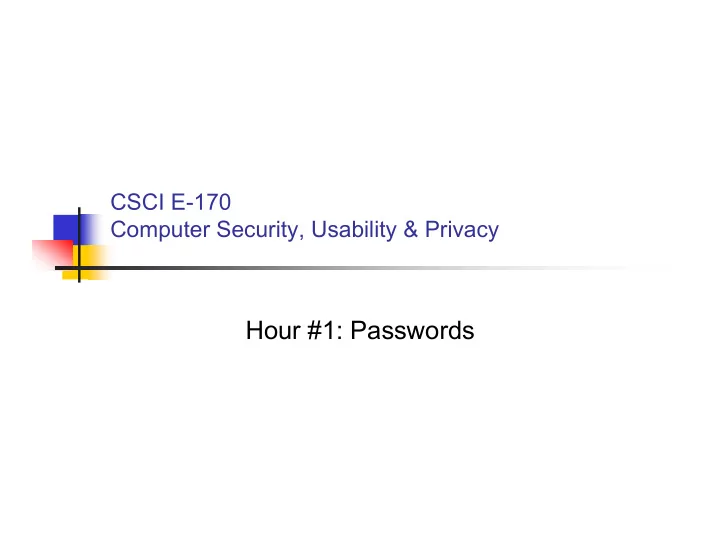

CSCI E-170 Computer Security, Usability & Privacy Hour #1: Passwords
Identification, Authentication, and Authorization Identification: You give your name Authentication: You’ve proven that it’s really you. Authorization: We’ve looked your identity up in the database and we know what you’re allowed to do. Most say “authentication” when they mean identification or authorization. You can authenticate without identifying.
Classical Authentication Something that you know password pass phrases Something that you are } biometrics fingerprint face print Something that you have tokens smartcards
Passwords: What are they good for? Today passwords are the #1 means of authenticating users on a day-to-day basis. Email, Websites, ATMs, Doors, Lockers, etc. Password Recovery: Challenge/response questions Knowledge of previous transactions
How many passwords do must you remember?
Why the explosion of passwords? Need to protect configuration information BIOS passwords, VChip, Cell Phones, etc. Web services need persistent identification of users over time No national/international identification service
Alternatives to many passwords Single-sign on: Master password unlocks others PKI: password unlocks private key Examples: Microsoft Passport Gnu Keyring (gnukeyring.sourceforge.net)
Observed Strategies “Low security” & “high security” passwords Standard password that’s changed for every host password-ebay password-paypall password-fas Change password periodically Every 3-6 months (Problems if you don’t manage to change all of your passwords.) Always use “password reset” and get emailed a password. Write passwords down
Anderson: 3 types of password concerns Disclosure Reliability to enter Ability to remember
Concern #1: Disclosure Will the user break the system security by disclosing the password to a third party, whether accidentally, on purpose, or as a result of deception?
Concern #2: Reliability to enter Will the user enter the password correctly with a high enough probability?
Concern #3: Ability to remember Will users remember the password, or will they have to either write it down or choose one that’s easy for the attacker to guess?
Can you write down passwords? class discussion
Can you write down these passwords? What if you had What if you had Can you Can you to remember 40 to remember 40 remember them? remember them? of them? of them? http://gs2.sp.cs.cmu.edu/art/random/archive/archive_0104/
A Password Policy “The root password for each machine shall be too long to remember, at least 16 alpha and numeric characters chosen at random by the system; it shall be written on a piece of paper and kept in an envelope in the room where the machine is located; it may never be divulged over the telephone or used over the network; it may only be entered at the console of the machine that it controls.” [Anderson, p. 37]
Anderson’s Research Problems in Passwords: What is the best way to enforce user compliance with a password policy? Can we design interactive password systems that are better? Can we use multiple passwords? Mother’s maiden name Password Amount of last purchase Dog’s nickname Your favorite color…
Threats to Passwords What are the threats against passwords? Guessing Brute force search Shoulder surfing Discovering passwords that are written down Passwords collected at one website used for another Kinds of attacks: Offline Online
Eavesdropping risks Physical device --- key grabber Trojan Horse Tapped lines Video Camera … The need for trusted path
Kinds of Attacks: Targeted attack on one account Attempt to penetrate any account on a system Attempt to penetrate any account on any system Service denial attack
Protecting against Online Attacks: Defenses Against Guessing: Exponential back-off Lock out Notification “Cracking” Dangers of lock-out eBay doesn’t use it; why not?
Protecting against Offline Attacks What do you do? Prevent people from getting the encrypted database. Make decrypting the database computationally difficult.
Restricting Passwords Does it make sense to mandate symbols and numbers in passwords? # of letters: 52 (26 lower + 26 UPPER) # of symbols: 30 # of 8 letter passwords: 52 8 # of 7 character passwords with 1 symbol: (52 7 )(30)(8) How about forcing 1 number and 1 symbol? (52 6 )(30)(8)(10)(7) But if you don’t mandate it, people won’t use them at all…
More on restrictions Different systems have different restrictions. Some require special characters Some forbid special characters. Why? Is this good or bad? (I find it annoying, but that’s because I want to use the same password on many different systems.)
Password Generating Algorithms Multics generated passwords that were “easy to remember.” What’s wrong with giving advice on how to generate passwords? What’s the alternative? Programmatically picking passwords that are easy-to-remember
Developer Recommendations Force users to change passwords regularly Password != Username Require 8 or more characters Require a mix of alpha, numeric, and special characters Deny Access After a number of failed Attempts Do not send passwords “in the clear” Do not assign “default passwords” Overwrite passwords in memory as quickly as possible
Restrictions on Passwords: Recommendations 1-14 characters vs. 1-127 characters vs. 10- 127 characters Recommendation: Mandate minimums, but allow people to type extra characters If you can’t handle a special character, change it to a character you can handle. ATM networks used to ignore all characters after first 4
Recommendations on Password Aging: What should we do? Should we mandate password changes? Should we remember old passwords and forbid them?
Case Sensitivity: Recommendations Some passwords are case-sensitive; some are not. If your passwords are not case-sensitive, they must be longer. Check password with case-flipped for CAPS LOCK ON accident.
Password Recovery What’s the best way to do it? Automatic vs. Manual “What is your favorite Color?”
Password Recovery: Recommendations Send a link that expires quickly. Specially log the IP address of the browser that clicks the link. Don’t send the password!
Web Password Hashing Internet Explorer plug-in that sends a hash of the password to every website. Hash depends on your password & remote website Defeats phishing! http://crypto.stanford.edu/PwdHash/ http://crypto.stanford.edu/PwdHash/PwdHash.ppt
Recommend
More recommend